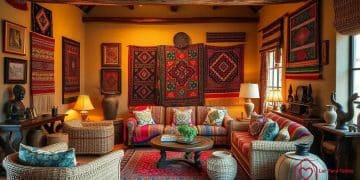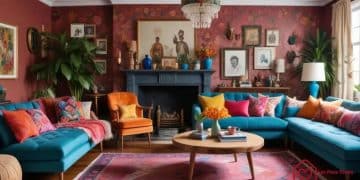African Design in Home Décor: A Complete Guide to South African Style

Interior décor in South Africa reflects a rich blend of cultures, traditions, and natural landscapes that deeply connect with African history and identity.
African design in home décor celebrates this unique cultural heritage, highlighting symbolic elements that evoke authentic environments through colors and textures.
In this cultural universe, South Africans have increasingly embraced décor that honors their roots, crossing different social classes and lifestyles.
Do you want to transform your home with the essence of African design in home décor? The first step is to understand what makes up this aesthetic. Explore the key elements and learn how to apply them to create a special and welcoming space.
Key Elements of South African Design for Home Décor
African design in home décor stands out for its connection to nature and the use of organic and sustainable materials that reflect South Africa’s diverse landscapes.
Wood and Natural Materials
Wood is one of the main materials used in African design for home décor.
Its presence recalls local forests and vegetation, used in rustic furniture, architectural details, and art objects.
Native woods like African oak or iroko create a direct connection with nature and provide both durability and aesthetic appeal.
In addition to wood, other natural materials such as straw, wicker, leather, and fiber ropes are essential elements.
They bring natural texture and a raw feel to the space. These materials are often seen in chairs, baskets, and rugs, providing an artisanal touch and enriching the environment.
Stones and Granite
The use of natural stones, such as granite, plays a central role in African design for home décor.
These stones appear in various forms, from floors and countertops to decorative items. Granite, in particular, is highly valued for its durability and aesthetics, making it a popular choice for both indoor and outdoor spaces.
Stones are also found in architectural elements, such as rustic stone walls or fireplaces, adding a sense of solidity and connection to the earth.
Ethnic Prints and Vibrant Colors
Ethnic prints are an essential part of African design in home décor, bringing vibrant energy and celebrating the cultural traditions of different South African ethnic groups, such as the Zulu, Xhosa, and Sotho.
These prints appear on pillows, rugs, curtains, and even furniture pieces.
Warm and vibrant colors, such as red, orange, yellow, and earthy tones, dominate, reflecting African landscapes—from deserts to forests.
They create an active and joyful atmosphere, ideal for anyone seeking to bring more life into their spaces.
Ancestral Portraits and Tribal Art
Art is a profound way to express African identity. In African home décor, portraits or images that honor ancestors and tribal leaders are essential.
These portraits, often accompanied by masks or sculptures, symbolize respect for history and family roots, reinforcing the sense of continuity and legacy within the home.
Crafts and Personalized Ceramics

South African crafts are renowned worldwide for their attention to detail. Each region of the country has its own distinct traditions, from handmade ceramics to woven textiles and wood carvings.
Incorporating local crafts into décor not only adds authenticity but also supports the local economy and preserves ancient cultural traditions.
Personalized ceramics are also featured in African design, often adorned with tribal and geometric patterns.
These pieces fit seamlessly into both formal and casual spaces, adding elegance and a unique aesthetic to the décor.
Local crafts play a central role in African design, with examples such as handwoven straw baskets, painted ceramics, and carved wooden sculptures.
These pieces not only decorate the space but also carry stories and a personal connection to the artisan who created them.
Natural materials like leather and stone are appreciated for their durability and organic touch, contributing to the space’s charm.
Options like recycled material baskets, hand-carved furniture, and bamboo lamps reflect South African traditions and landscapes, giving any décor a distinctive character.
Textures and Fabrics
Natural fabrics and varied textures are key components of African design for home décor.
The use of cotton, linen, wool, and traditional fabrics like shweshwe—a printed fabric popular in Xhosa culture—adds a layer of visual and sensory richness to the space.
Handmade straw or wool rugs offer extra comfort and connect the home with ancestral weaving practices.
Mixing textures—such as soft rugs combined with robust wooden furniture—is characteristic of African design, creating contrast and balance at the same time.
Patterns and Prints
Geometric patterns and tribal prints, with bold lines and abstract shapes, are deeply embedded in African home décor.
Inspired by cultural traditions, these patterns are found in fabrics, ceramics, rugs, and even wall paintings.
In South Africa, Ndebele patterns, known for their colorful and symmetrical geometric designs, are particularly iconic, representing the vibrant artistic heritage of the region.
These patterns can be used to create focal points in a room or add personality to furniture and accessories.
Whether bold and dynamic or subtle, patterns can suit various aesthetic preferences.
Rustic Furniture
Furniture in African design for home décor is often rustic and sturdy, made from materials like wood and wrought iron.
The goal is durability, reflecting the resilience of outdoor life in Africa. By choosing rustic pieces, you introduce a natural touch to the décor while embracing longevity and cultural tradition.
Carved wooden furniture or those with distressed finishes offer timeless charm and can be paired with contemporary objects to create a balanced blend of old and new.
Trends in South African Interior Design

Although African design for home décor is deeply rooted in traditions, it continuously evolves by incorporating modern and sustainable trends.
The pursuit of eco-friendly solutions—such as using recycled materials and promoting solar energy—has become common in South African homes.
This movement seeks to balance respect for tradition with environmental consciousness, creating aesthetically pleasing and sustainable spaces.
The blending of styles is also on the rise, with many South Africans combining traditional design with contemporary touches.
An example is using minimalist pieces in spaces with rustic and colorful elements, creating a modern yet culturally rooted environment.
Supporting Artisans in Home Décor
One of the most authentic ways to incorporate African design into home décor is by supporting local artisans.
By purchasing handmade products such as furniture, textiles, and art objects, you ensure quality and authenticity while contributing to the local economy and preserving cultural traditions.
In South Africa, supporting artisans helps value heritage and fosters the growth of communities that rely on crafts for their livelihood.
Many artisans use ancient techniques passed down through generations. Choosing their creations adds a unique, exclusive touch to your home, while also celebrating the creativity and talent of local communities.
Incorporating elements like wood, natural stones, ethnic prints, and local crafts allows you to create a space that reflects your identity while supporting the preservation of traditions and talents.
Did you enjoy these tips? By understanding and applying these principles, you can transform any space into a sanctuary that authentically celebrates South African roots with style and meaning.






